Battle Britain Memorial |
|
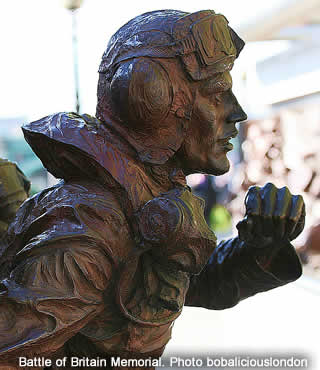 |
|||
A physical memory of World War II's crucial conflict |
||
"The Battle of France is over", Winston Churchill said. "The Battle of Britain is about to begin". It was June, 1940. Sure enough, four days later France surrendered, and the Nazis turned their attention north. Their problem was that any crossing of the Channel would be prevented by the Royal Air Force. Hitler therefore decreed that "the English air force must be beaten down to such an extent morally and in fact that it can no longer muster any power of attack worth mentioning against the German crossing" Just as Churchill had predicted, the Battle of Britain was underway. |
||
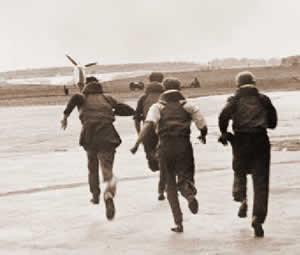 SCRAMBLE! Fighter pilots running to their aircraft |
||
Throughout the summer, attacks came on a near daily basis. In July tentative fights broke out over the Channel. The British defences began to be tested. In August the focus switched to aircraft factories and RAF airfields. This was the largest part of the offensive. In September the targets were switched again, to major cities like London and Plymouth. |
||
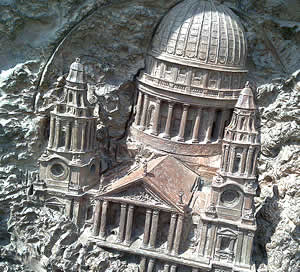 Depiction of the bombing of St Paul's on the monument Photo Mark Hillary |
||
On paper, these assaults should have been overwhelming. The Luftwaffe (the German air force) had 4000 active aircraft to the RAF's 1660. On several occasions the Nazi leaders were convinced that their enemy was on the brink of defeat, but somehow each raid was met by another squadron of planes. It was as if reinforcements were being conjured out of thin air. |
||
In truth, the British benefitted greatly from their home advantage. The battle was fought over England, where damaged planes could be salvaged, pilots could be rescued, and both could be quickly returned to service. For the Luftwaffe, this wasn't possible; anything that got shot down was lost forever. If a plane ran out of fuel or bullets, it had to make the long trip back across the Channel. |
||
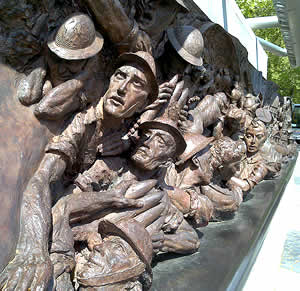 The monument depicts all the various people involved in the Battle Photo Mark Hillary |
||
Another Allied advantage was radar. This quickly developing technology was known to the Luftwaffe, but they severely underestimated its effectiveness. They directed their bombers elsewhere, leaving most radar bases fully functional. They were free to collect vital information about imminent attacks and their targets. |
||
The defensive force was made up almost exclusively of Hurricane and Spitfire class planes. The latter machines were particularly celebrated for their manouverability and firepower. They were produced throughout the battle in as high a volume as possible, and have since become a symbol of British victory. |
||
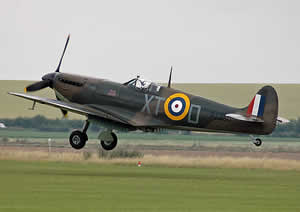 A Spitfire from the Battle of Britain Memorial Flight Photo Kogo |
||
That victory took place on 17th September, when Hitler officially postponed his invasion of England. it was far from the end of the war, but it was deeply significant. Historians speculate that defeat in the Battle of Britain would have meant losing the entire war. |
||
The RAF's achievements are permanently commemorated on the north bank of the River Thames. The Battle of Britain Memorial makes use of a 25-metre granite block that was originally used to vent smoke from underground steam trains. It was recycled by the sculptor Paul Day, who completed the project in 2005. Two detailed bronze panels depict different aspects of the battle. Tribute is paid to everyone that contributed to the victory, from observers to mechanics. There's even a depiction of an air raid shelter, where civilians are defiantly making tea. It seems it would take much more than a World War to keep the British from a brew. |
||
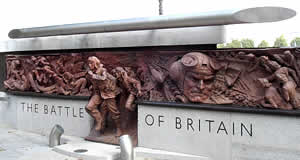 The Battle of Britain Monument Photo Lonpicman |
||
Of course, the major focus of the monument is on the pilots, who risked their lives on a daily basis. Life-size representations of these brave young men burst out of the wall, out onto the pavement. They would experience this moment all too often: scrambling for their Spitfires to repel another attack, never certain that they'd return, but sprinting all the same. |
||
As Churchill himself said, "never in the field of human conflict has so much been owed by so many to so few" |
||
|
||
The Battle of Britain Memorial can be found on the Victoria Embankment in Westminster, not far from Westminster Tube station. |
||
|
Pocket Britain is optimised for use on a smartphone or tablet with internet access. All content is subject to copyright. All reasonable methods have been used to ensure information supplied is accurate at the time of publication. However, it is advisable to check information before relying on it. Privacy Policy |